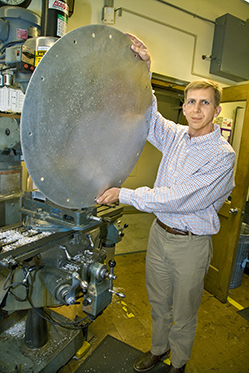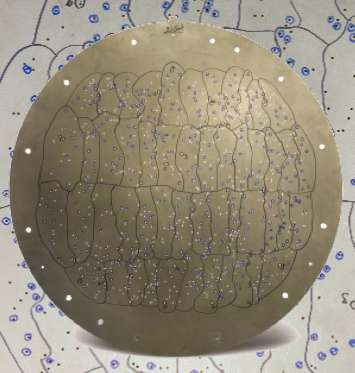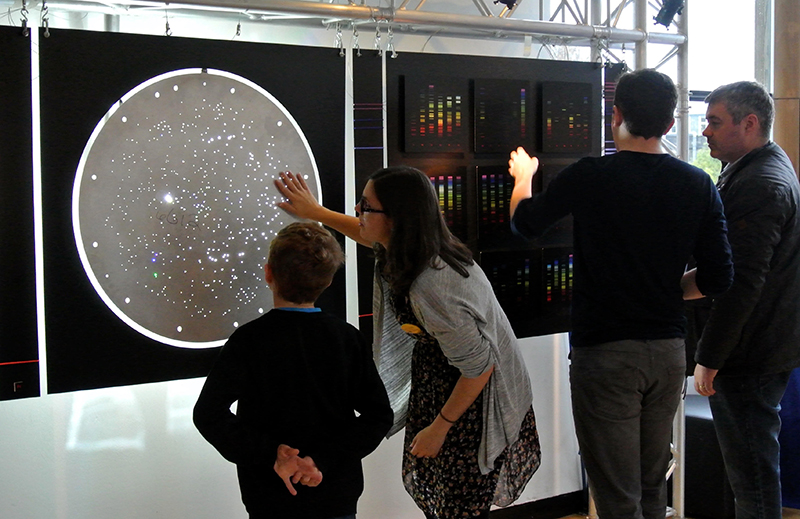
Image credit: Lawrence Berkeley National Laboratory
They may not look like much — just metal disks 80 centimeters (30 inches) across with some etched markings and hundreds of small holes — but round aluminum “plates” like this one from the Sloan Digital Sky Survey (SDSS) have been vital to mapping our universe for more than 20 years.
“The light passing through these plates has helped us search for answers to an enormous range of questions that we want to ask about our Universe, from nearby stars and planetary systems to distant galaxies and giant black holes,” says Gail Zasowski, the scientific spokesperson for SDSS-V.
The plates enabled the SDSS to use one of the most powerful techniques in astrophysics: splitting the light from an object up into the rainbow of its constituent colors to create a graph called a “spectrum,” which shows how much light of different energies the object emits.
Studying the spectrum of a galaxy can tell us details like how far away it is, how long ago its stars formed, and even how those stars orbit the supermassive black hole at the galaxy’s center. The spectrum of the gas falling into that black hole can help us calculate how big the black hole is and how quickly it is growing. For an individual star, a spectrum can tell us its temperature, the chemical elements of which it is made, and how quickly it is moving towards or away from us. Multiple spectra of the same star over time can even be used to detect the presence of orbiting exoplanets or faint companions.

Image credit: Sloan Digital Sky Survey
Astronomers have studied spectra of objects in the sky for centuries, but over time a problem appeared. Traditionally, astronomers relied on tiny slits in metal sheets to pass the light from single — or at most, a few — stars or galaxies into one spectrograph (a device that measures a spectrum), often a laborious process. As sky surveys got bigger and needed to collect spectra for more and more stars and galaxies, it became impractical to wait for spectrographs to collect all the data using these traditional methods. A new approach was needed.
The solution came at the end of the 1990s, when astronomers and engineers from the SDSS began to drill hundreds of holes in large aluminum plates, each hole positioned to line up with a star or galaxy towards a particular patch of the sky as shown in this video of SDSS plates being drilled. When the plate was set at the back of the telescope, an optical fiber, carefully plugged by hand into each hole as shown in this video of observers plugging fibers into an SDSS plate, carried the light from the star or the galaxy into a spectrograph. This new system allowed several hundred spectra to be collected at the same time, dramatically increasing the speed at which objects in the sky could be measured.
In fact, SDSS-IV Director Mike Blanton explains that “the very first batch of data we used in early 2000 was almost as big as any of the previous redshift surveys ever done, and that was just from the first month or two of observations!”

Image credit: J. Burchett
Since those early measurements, more than twelve thousand plates have been drilled, hand-plugged, and observed. That’s a lot of metal — if all of these plates were piled together, their combined weight would equal that of twelve African bull elephants — or, for astronomers, a cube of white dwarf star material just under 4 centimeters (one and a half inches) on each side. All those plates would contain enough metal to make 4.3 million soda cans. All of these plates were drilled by engineers at the University of Washington’s machine shop, and each hole in each plate was plugged in by hand by staff at one of the SDSS’s telescopes in New Mexico and Chile.
The appearance of the plates has evolved over time, as the SDSS started new surveys, built new spectrographs, and even started using different telescopes. Many of the plates from recent years have more than one thousand holes each, or have holes for fibers from multiple spectrographs at the same time, or have holes that can accommodate bundles of dozens of optical fibers packed together. All told, more than 5.3 million individual holes have been drilled, each to within a tolerance of 10 micrometers (4 ten-thousandths of an inch). If you had to count all of these holes one-by-one, it would take you more than 60 straight days with no breaks.

Image credit: Jordan Raddick (JHU), Niall Deacon (MPIA), and the Sloan Digital Sky Survey
What have we learned from the photons that passed through all those holes? They comprise the spectra of over four million stars, galaxies, and quasars. In turn, these spectra have been used to measure how old the universe is, how much dark matter is in it, how its expansion is accelerating, and how its billions of galaxies formed and evolved over time. As SDSS continued observing over the years, it increasingly focused on the detailed history of our own Milky Way and nearby galaxies, and on how stars are born, evolve, die, and create the elements of which we ourselves are made. You can learn more about all the amazing results of the SDSS from our list of press releases.

Image credit: T. Fitzpatrick
One of the best parts of all this information is that it is available any time to anyone, anywhere. “Every single spectrum observed by the SDSS is made available online, not just for astronomers, but for the whole world to study,” says Anne-Marie Weijmans, who oversees the effort to document and release these massive quantities of data. The enormous number of discoveries made using SDSS data have involved researchers all over the world, often asking questions or using the data in ways that were not even envisioned when the survey was designed.
In addition to the vast scientific knowledge and online data troves enabled by this system, SDSS plates have provided a way for countless schoolchildren and members of the public to interact with real astronomical hardware and data. “To date, the SDSS’s Plates for Education program has distributed several hundred plates — all of which have been used to observe the sky — to schools, museums, and other educational institutions around the world,” explains Romina Ahumada, who leads these SDSS educational efforts in Chile.
Contacts
Gail Zasowski
Scientific Spokesperson, SDSS-V
University of Utah
+1 (801) 581-6901
gail.zasowski@gmail.com
Michael Blanton
Director, SDSS-IV
New York University
+1 (212) 998-7770
blanton@physics.nyu.edu
Anne-Marie Weijmans
SDSS-IV Data Coordinator
University of St Andrews
+44 (0)1334 462823
amw23@st-andrews.ac.uk
Romina Ahumada
Instituto de Astronomía, Universidad Católica del Norte, Chile
+56 9 6674 5782
rommy.ahumada@gmail.com
Juna Kollmeier
Director, SDSS-V
Carnegie Institution for Science
+1 (626) 304-0220
jak@carnegiescience.edu
The Plates for Education program has developed materials to help everyone learn about the celestial objects observed with the very plate in their hands, and to help educators incorporate the plates into their curricula to teach numerous astrophysical concepts. To learn how these curricula work, watch this online workshop given by SDSS astronomers Britt Lundgren and Gail Zasowski.
Artists around the world have also explored numerous aspects of the plates as windows to the universe, including Jian Yang in Beijing, Josiah McElheny in New York City (see also this preprint describing his work), and SDSS’s own Artist-in-Residence Tim Fitzpatrick.
Now, after over two decades of using these plates to support its data collection (literally and metaphorically), the Sloan Digital Sky Survey is moving to a new era — one in which tiny robots will position each optical fiber to match the location of a star, galaxy, supermassive black hole, or other target. This is the perfect time to look back at the monumental scientific contribution of the plates, as the team plans for the next major developments that will be enabled by the new, even faster system.
As Juna Kollmeier, the Director of the brand-new fifth phase of the SDSS project (SDSS-V), says, “The plates have been amazing. In graduate school, I worked with the first ones, and it’s humbling to think of all we have learned and all we still have to discover.”
Although observations with the SDSS plates have now ended, the survey looks ahead to an even brighter future. SDSS-V observations have already begun, using a sophisticated system in which robots repeatedly arrange and rearrange the optical fibers, allowing far more objects to be observed in far shorter times. Kollmeier continues, “With SDSS-V and its robots, we will now be able to fully probe the entire sky with spectra, repeatedly in time, and make that data available to the world. How does the Universe change over days, weeks, or even years? We’ve had key snapshots of the universe — now it’s time to make the movie.”
Press Releases
All prior SDSS press releases can be found in the press release archives of the various phases of the SDSS:
SDSS-IV Press release archive
SDSS-III press release archive
SDSS-I/-II Press release archive
Acknowledgements
Funding for the Sloan Digital Sky Survey V has been provided by the Alfred P. Sloan Foundation, the Heising-Simons Foundation, and the Participating Institutions. SDSS acknowledges support and resources from the Center for High-Performance Computing at the University of Utah.
SDSS is managed by the Astrophysical Research Consortium for the Participating Institutions of the SDSS Collaboration, including the Carnegie Institution for Science, Chilean National Time Allocation Committee (CNTAC) ratified researchers, the Gotham Participation Group, Harvard University, The Johns Hopkins University, L’Ecole polytechnique fédérale de Lausanne (EPFL), Leibniz-Institut für Astrophysik Potsdam (AIP), Max-Planck-Institut für Astronomie (MPIA Heidelberg), Max-Planck-Institut für Extraterrestrische Physik (MPE), Nanjing University, National Astronomical Observatories of China (NAOC), New Mexico State University, The Ohio State University, Pennsylvania State University, Smithsonian Astrophysical Observatory, Space Telescope Science Institute (STScI), the Stellar Astrophysics Participation Group, Universidad Nacional Autónoma de México, University of Arizona, University of Colorado Boulder, University of Illinois at Urbana-Champaign, University of Toronto, University of Utah, University of Virginia, and Yale University.

